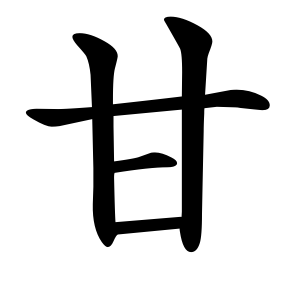甘
- sweet;
Etymology
The character 甘 ("gam") is a phono-semantic compound formed by adding the symbol 一 inside the character 口 (mouth), representing the meaning of "having taste" or "sweetness." It can also mean "willingly" or "gladly."
In Japanese, it is read as "ama" (訓読み, kun’yomi). Historically, in medieval Japanese, this term was used to mean "lacking saltiness" (i.e., bland), and over time its meaning expanded to include "awkward," "soft," or "ineffectual," deriving from the image of a person who is bland like unsalted food.
Characters with 甘
9 strokes
甘
달
감
dal
kam
Kangxi radical:99
Strokes:5
Unicode:U+7518
Cangjie input:
- 廿一 (TM)
Composition:
- ⿻ 廿 一
